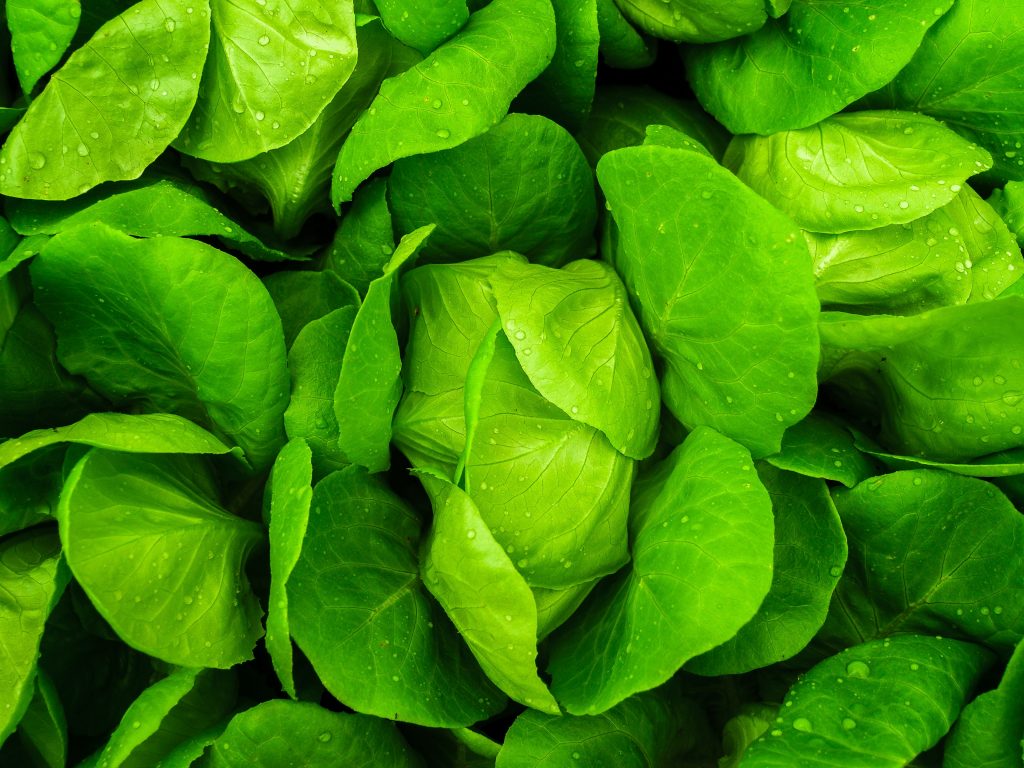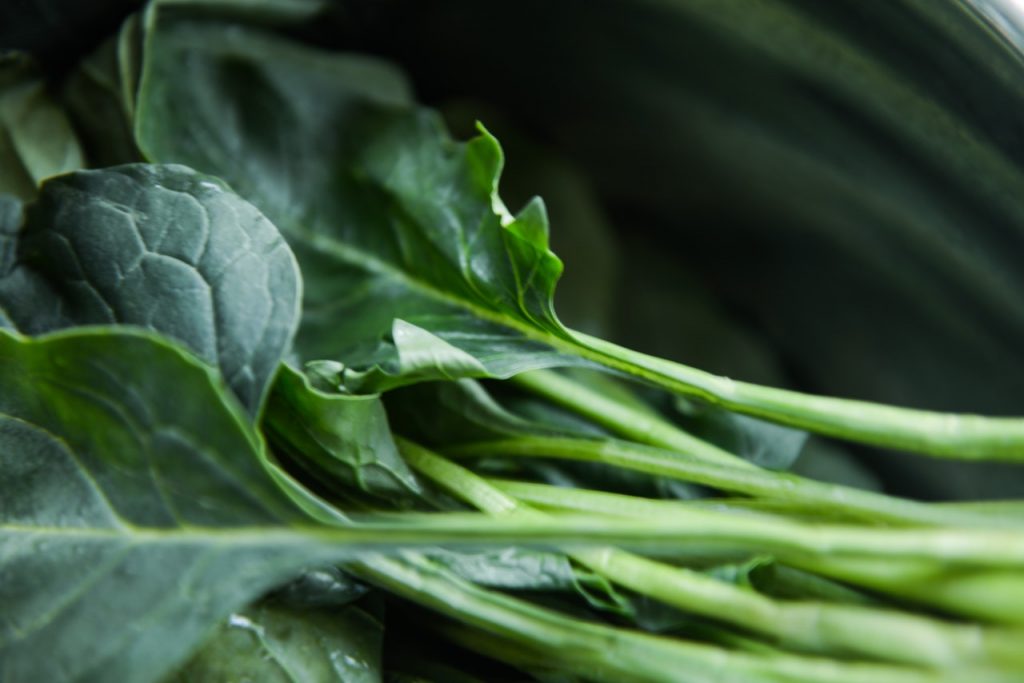by M. Bunning and P. Kendall1 (6/12)
Quick Facts…
- Lettuce, spinach, and other salad greens are an important part of a healthful diet because they can be year-round sources of vitamin A, vitamin C, and other nutrients.
- Red and dark green leafy vegetables are generally higher in antioxidants, Vitamin B6, and other nutrients than lighter colored greens.
- It is important to store leafy greens at refrigerator temperatures and rinse well under running water before using.
- To reduce the risk of foodborne illness, observe “Use by” dates printed on bagged leafy vegetables and salad mixes and use within two days after opening.
- There are many flavorful and nutritious leafy greens available to consumers, especially if you choose to grow them from seed.

Benefits of Leafy Salad Greens
Leafy green vegetables are nutrient rich because leaves contain the light-catching, energy-converting machinery of plants. Salad greens contain Vitamin A, Vitamin C, beta-carotene, calcium, folate, fiber, and phytonutrients (see Table 1). Leafy vegetables are a good choice for a healthful diet because they do not contain cholesterol and are naturally low in calories and sodium. Many of the health benefits that leafy greens provide come from phytonutrients, unique compounds that provide protection for plants. These compounds are becoming recognized as part of a nutritious diet that promotes long-term health. Phytonutrients can act as antioxidants, which help to prevent chronic diseases like cancer and heart disease. Figure 1 shows the antioxidant content of different kinds of lettuce.
| Table 1. Nutrients in various lettuce types. | |||||||
| Nutrient* | Units | Lettuce Type | |||||
| Iceberg | Green Leaf | Red Leaf | Romaine | Butterhead | Kale[WU1] ** | ||
| Vitamin A | IU | 502 | 7405 | 7492 | 8710 | 3312 | 4812 |
| Vitamin B-6 | mg | .042 | .09 | .100 | .074 | .082 | 0.147 |
| Vitamin C | mg | 2.8 | 9.2 | 3.7 | 4 | 3.7 | 93.4 |
| Vitamin K | mg | 24 | 126 | 140 | 103 | 102 | 390 |
| Folic Acid | mcg | 29 | 38 | 36 | 136 | 73 | 62 |
| Niacin | mg | .123 | .375 | .321 | .313 | .357 | 1.180 |
| Riboflavin | mg | .025 | .080 | .077 | .067 | .062 | 0.347 |
| Iron | mg | .41 | .86 | 1.2 | .97 | 1.24 | 1.60 |
| Potassium | mg | 141 | 194 | 187 | 247 | 238 | 348 |
| ß-carotene | mcg | 229 | 4443 | 4495 | 5226 | 1987 | 2873 |
| Lutein + Zeaxanthin | mcg | 277 | 1730 | 1724 | 2312 | 1223 | 6261 |
|
Shaded cells indicate highest
values.
*100g fresh weight/USDA
National Nutrient Database for Standard Reference, Release 24 (2011) and USDA
Nutrient Database for Standard Reference, Legacy Release (2018)
**Did you know, that although
kale is commonly eaten in salads and wraps like different lettuces, it is
actually a cruciferous vegetable,
such as broccoli and cauliflower! |
Lettuce, the most commonly consumed leafy vegetable, provides about seven calories per 1 cup serving. When it comes to satisfying your appetite, it helps to eat foods high in volume but low in calories like lettuce. Lettuce is not typically a standalone vegetable. It is usually served with an array of other vegetables and fruits in a salad and lettuce is often used to add a crunch to sandwiches, hold a variety of fillings as a wrap, or provide color as a garnish.

Lettuce and other leafy greens are generally cool season crops with short growing periods. This means gardeners can get several crops of salad greens in the time it takes other vegetables to reach final maturity. Because leafy greens can grow in a variety of locations, they are often available at local farmers’ markets. Home-gardeners can enjoy lettuce and other types of leafy vegetables planted in traditional rows, containers, or even as accents in flower gardens.
Types of Lettuce

Many types of lettuce are available in the grocery store and may be purchased by the head or as prepackaged salad greens. Different types have slightly different flavors.
Some have a mild flavor and crisp texture; others have a slightly bitter or tangy flavor that adds a nice bite to mixed salads. Salad greens are popular world-wide so many of the different types have become known by a variety of names. Information about different types of lettuce and salad greens is listed in Table 2.
Tips for Healthier Salads
For added color and variety, try a different type of salad green to mix with your usual choice. Baby greens (such as baby spinach) tend to be more tender, nutritious, and milder in flavor than mature greens. Use less dressing to enjoy the flavor of the salad greens.
See the following Extension fact sheets for additional information on produce safety:
9.369, Preventing E. coli From Garden to Plate
9.378, Growing Container Salad Greens
9.380, Guide to Washing Fresh Produce
9.381, Safe Food Facts for Community Gardens
Tips for Safe Handling and Storage of Salad Greens
- When shopping, pack fresh salad greens in plastic bags so they are kept separate from other groceries, especially raw meats and poultry.
- Refrigerate salad greens at 35 to 40 degrees F within two hours of purchasing. Store in a plastic bag or lettuce keeper.
- Always wash hands before preparing salads and make sure you are working with a clean cutting board.
- Wash lettuce just before using by running cold water over leaves. Leaves can be difficult to clean so separating the leaves and immersing them in a bowl of cold water for a few minutes helps loosen sand and dirt. A bowl is a much better choice than a sink, which can harbor bacteria and be difficult to clean. Presoaking lettuce for 5 minutes in dilute vinegar-water (1/2 cup distilled white vinegar per 2 cups water), followed by a clean water rinse, has been shown to reduce bacterial contamination but may affect texture and taste. A vinegar rinse will not eliminate all microorganisms but may lower the level of possible contamination. After washing, blot dry with paper towels or use a salad spinner to remove excess moisture.
- Because lettuce and other salad greens are very perishable, they should be used within one week after purchase.
- Bagged salads can be convenient but added processing steps like cutting and mixing can increase the likelihood of contamination with microorganisms. To reduce the risk of foodborne illness with bagged salads keep them refrigerated at 35 to 40 degrees F, observe “Use By” dates marked on the package, and rinse well before eating, removing any damaged or spoiled leaves.
| Table 2. Commonly available salad greens. | ||
| Name | Characteristics | |
| Commonly available types of lettuce | ||
|
Green Leaf (loose leaf or salad bowl) | Green leaf lettuce forms a loose bunch and is known for its mild flavor. | |
|
Red Leaf (lollo rosso) | Red leaf lettuce makes a colorful addition to salads and sandwiches. Studies have shown red lettuce to be high in antioxidants (Figure 1). Red leaf lettuce is more perishable than head types and has a shorter shelf life. | |
| Romaine(cos) | Romaine lettuce, a Caesar salad favorite, has elongated, sturdy leaves. Romaine stores well and its coarse texture holds up well in salads. | |
|
Butterhead (bibb or Boston) | This lettuce has tender, rounded leaves with a mild, buttery flavor that form into a soft head. It is often sold in a clam shell to protect its tender leaves. | |
|
Iceberg (head or crisphead) | Iceberg is prized for its crispness and sweet flavor. It can be stored longer than leaf types of lettuce. | |
|
Batavia (French Batavia) | Batavia lettuce is a subtype of crisphead lettuce and is similar to iceberg except it is smaller, less dense and more flavorful. Batavia lettuce is popular in Europe and may be found at farmers’ markets or grown in home gardens. | |
| Salad greens that may be part of a salad mix or sold separately | ||
|
Arugula (rocket) | Arugula belongs to the mustard family and has a distinctive peppery flavor. The young fresh leaves are pungent but pleasant and often available in grocery stores. | |
| Baby Bok Choy | These tender young leaves have a crunchy, celery-like texture and a mild, refreshing flavor. | |
|
Belgian Endive (witloof chicory) | Belgian endive has a dense, cigar-shaped head of crunchy leaves that are pale yellow because it is grown under cover. It is often used in hors d’œuvres, but can be added to salads. | |
|
Curly Endive (frisée) | These attractive, yellowish-green, frilly leaves have a strong, pleasantly bitter taste. | |
| Dandelion greens | These relatives of lettuce are available in some grocery stores. If you collect them yourself, choose young plants that have not been exposed to pesticides. | |
| Escarole | The taste of this broad-leafed endive varies from mild in the lighter-colored portions to bitter in the darker green leaves. | |
| Kale | Kale is known for being high in many nutrients and has a strong, bitter taste when mature, but a pleasant flavor when eaten as a baby green. | |
|
Mache (corn salad, lamb’s lettuce) | Mache has an unusual but pleasant, nutty flavor. Because its leaves are very delicate, it’s usually sold separately rather than included in salad mixes. | |
| Mesclun | Mesclun is French for a mixture of tender young lettuces (baby greens) and other salad greens. The traditional mesclun mix includes chervil, arugula, lettuce and endive. | |
|
Mizuna (oriental greens) | Mizuna has deeply cut, fringed leaves with a tangy flavor. | |
|
Radicchio (red chicory) | Radicchio is a type of chicory that has dark red leaves with white veins that form into a small, loosely wrapped, cabbage-like head. Radicchio is known for its bittersweet taste. | |
| Spinach | Young spinach leaves are nutritious and flavorful, alone or mixed with other salad greens. Savoy types of spinach have more wrinkled and curly leaves than smooth types. | |
| Watercress | These spicy, robust leaves are a pleasing addition to salads and they are also good on sandwiches. |
Resources & References
Bunning, M. 2007. Evaluation of Antioxidant and Sensory Properties of Multiple Cultivars of Colorado-grown Lettuce (Lactuca sativa L.). PhD Dissertation. Department of Food Science & Human Nutrition, Colorado State University, Fort Collins, CO.
Chang, J. and Fang, T. 2007. Survival of Escherichia coli O157:H7 and Salmonella enterica serovars Typhimurium in iceberg lettuce and the antimicrobial effect of rice vinegar against E. coli O157:H7. Food Microbiology 24: 745-751.
Produce Safety, U. S. Food and Drug Administration, Center for Applied Food Safety & Applied Nutrition. Available online at: https://www.fda.gov/about-fda/fda-organization/center-food-safety-and-applied-nutrition-cfsan
U.S. Department of Agriculture, Agricultural Research Service. 2011. USDA National Nutrient Database for Standard Reference, Release 24. Nutrient Data Laboratory Home Page, http://www.ars.usda.gov/ba/bhnrc/ndl
*M. Bunning, Colorado State University Extension food safety specialist and assistant professor, department of food science and human nutrition; P. Kendall, Ph.D., R.D., Colorado State University, associate dean of research, food science and human nutrition.6/07.
Colorado State University, U.S. Department of Agriculture, and Colorado counties cooperating. CSU Extension programs are available to all without discrimination. No endorsement of products mentioned is intended nor is criticism implied of products not mentioned.


